The Home Brew Boiler Market is estimated to be valued at USD 1095.6 million in 2025 and is projected to reach USD 1853.8 million by 2035, registering a compound annual growth rate (CAGR) of 5.4% over the forecast period.
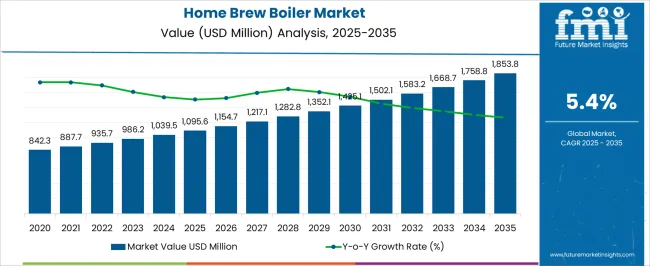
| Metric | Value |
|---|---|
| Home Brew Boiler Market Estimated Value in (2025 E) | USD 1095.6 million |
| Home Brew Boiler Market Forecast Value in (2035 F) | USD 1853.8 million |
| Forecast CAGR (2025 to 2035) | 5.4% |
The Home Brew Boiler market is experiencing steady expansion as consumers increasingly embrace home-based brewing practices driven by a growing culture of craft beer and DIY food and beverage preparation. The current market landscape is shaped by rising demand for user-friendly, energy-efficient brewing systems that provide greater control over brewing variables. Technology-focused publications and product manufacturer updates have highlighted increased consumer interest in customizable, scalable systems suitable for personal use.
Additionally, heightened awareness of product quality, ingredient sourcing, and experimentation at home is prompting a surge in adoption. Industry news and investor statements suggest that future growth will be sustained by innovation in compact boiler designs, integration with smart controls, and rising participation in local and global home brewing communities.
The emphasis on hobbyist culture, sustainability, and energy conservation has also supported a growing preference for software-enabled and efficient brewing systems These dynamics are expected to position the market for sustained growth in both established and emerging economies over the coming years.
The market is segmented by Technology, Application, and Capacity and region. By Technology, the market is divided into Electric System and Gas Fired System. In terms of Application, the market is classified into Beer, Wine, and Others. Based on Capacity, the market is segmented into 1-10 Gallon Kit, 1 Gallon Kit, and Above 10 Gallon Kit. Regionally, the market is classified into North America, Latin America, Western Europe, Eastern Europe, Balkan & Baltic Countries, Russia & Belarus, Central Asia, East Asia, South Asia & Pacific, and the Middle East & Africa.
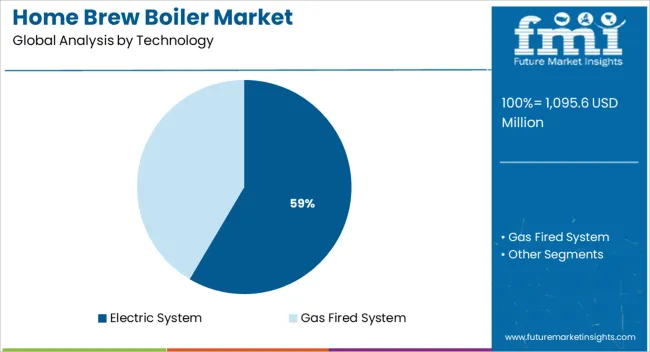
The electric system segment is expected to account for 58.5% of the Home Brew Boiler market revenue share in 2025, making it the leading technology segment. Its leadership is being driven by the increasing demand for energy-efficient, precise, and compact systems suitable for home use. Electric systems have been favored due to their ease of installation, consistent temperature control, and compatibility with smart brewing components.
Reports from product engineering teams and consumer appliance news portals have highlighted their ability to provide steady heating without the complexities of gas or open flame systems. Moreover, the rising number of urban consumers with limited access to traditional gas infrastructure has contributed to the strong growth of electric systems.
The segment’s dominance is further reinforced by safety advantages, lower operational costs, and reduced emissions, which align with sustainability preferences among hobbyist brewers The ability to integrate automation features in electric systems has also played a pivotal role in shaping its market leadership.
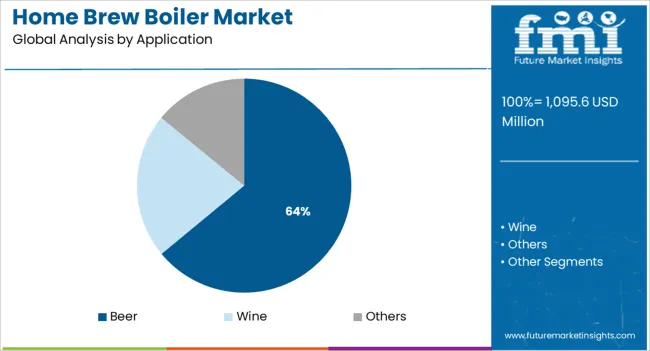
The beer application segment is projected to hold 64.0% of the Home Brew Boiler market revenue share in 2025, making it the dominant application area. This strong position is supported by the rising popularity of home-brewed craft beer, as reported in beverage industry journals and product adoption trends. A growing number of consumers are engaging in beer brewing at home for both recreational and small-scale commercial purposes.
The segment’s growth has been aided by the availability of comprehensive brewing kits and digital tools that simplify the beer-making process. Manufacturer insights and product releases have emphasized improvements in user-friendly design and programmable controls that appeal to hobbyists focused on beer brewing.
Additionally, consumer interest in ingredient sourcing and flavor experimentation has been stronger in beer than in other home-brewed beverages, further boosting demand The long-standing cultural presence of beer brewing across regions has also helped this application maintain its dominance in the market.
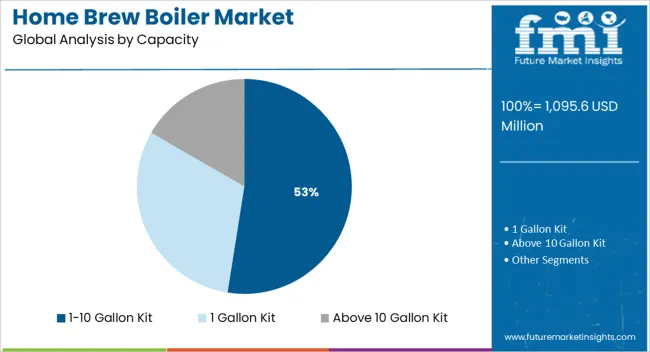
The 1 to 10 gallon kit segment is anticipated to contribute 52.5% of the Home Brew Boiler market revenue share in 2025, making it the largest capacity-based segment. The segment’s leadership is attributed to its suitability for hobbyist and small-scale brewers who prefer manageable volumes for experimentation and personal consumption. Product development updates and home brewing forums have highlighted the convenience, affordability, and portability of smaller capacity kits.
These systems are often designed to be space-efficient and easy to clean, addressing key concerns of home users operating in limited spaces. Furthermore, increased marketing efforts and online tutorials targeting beginners have significantly supported adoption in this range.
Manufacturers have also focused on improving performance features and customization options within this capacity range, increasing its appeal The popularity of brewing clubs and educational workshops that promote entry-level brewing has reinforced the continued demand for compact systems in the 1 to 10 gallon category.
The global market for homebrew boilers increased at 4.0% CAGR from 2020 to 2025 and reached a valuation of USD 1095.6 Million in 2025. However, with rising consumer interest in preparing their own beer, total home brew boiler demand is anticipated to grow at 5.4% CAGR during the forecast period (2025 to 2035).
Today, a large portion of the world population is showing a keen inclination towards brewing alcoholic beverages like beer and wine at home. In fact, homebrewing has become a more affordable and versatile choice for consumers. This rising popularity of home brewing is thus emerging as a key factor generating demand for home brewing equipment like home brew boilers.
Another reason is that there are more options for people who want to brew their own beer. There are now many different types of home brewing kits available, which makes it easier for people to get started without spending a lot of money.
Similarly, a growing number of craft breweries supported by high consumption of craft beer is expected to elevate home brew boiler demand over the next ten years.
Various influential factors have been identified by FMI that is likely to aid in the expansion of the global home brew boiler industry during the assessment period (2025 to 2035). Besides this, FMI analysts have also analyzed the upcoming threats, restraining elements, and lucrative opportunities that can somehow influence home brew boiler market demand.
The drivers, restraints, opportunities, and threats (DROTs) identified are as follows:
DRIVERS
RESTRAINTS
OPPORTUNITIES
THREATS
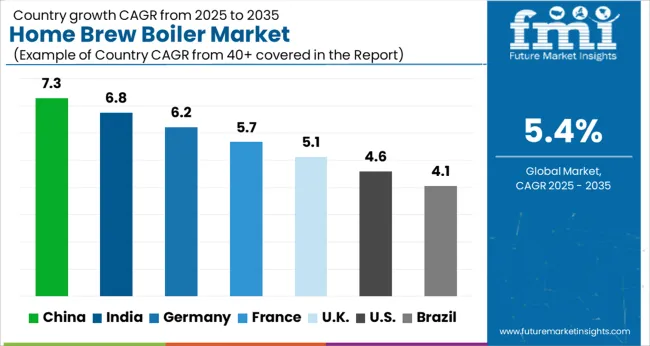
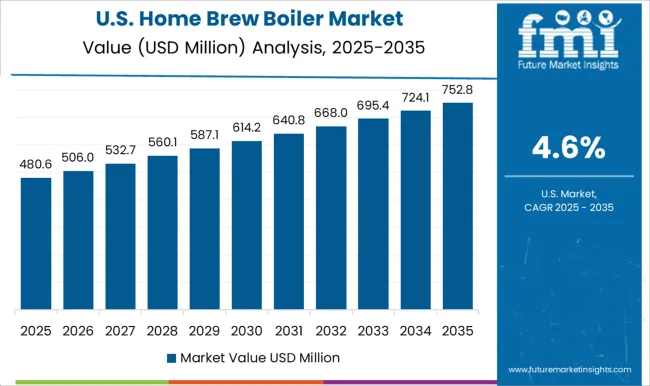
Rising Popularity of Homebrewing Propelling Home Brew Boiler Demand in the USA
The USA accounts for nearly 34.6% of the global home brew boiler industry and it is expected to reach a valuation of USD 1095.6 Million in 2025. The increasing popularity of homebrewing, availability of advanced home brewing equipment, and rising consumption of craft beer are some of the key factors driving the USA home brew boiler market forward.
There has been a growing interest in homebrewing across the USA during the last few years. For instance, as per the latest released data by the American Homebrewers Association (AHA), over 842.3 Million people in the USA homebrewed their own beer in 2020.
Furthermore, among these 842.3 million people, around 40% of them started this hobby (homebrewing) within the last four years. This growing popularity of homebrewing is acting as a catalyst triggering home brew boiler sales in the country and the trend is expected to continue during the forecast period.
Similarly, In the United States, the home brewing market is evolving with home brewers increasingly looking for new innovative beer and wine-making equipment for improving the quality of their alcoholic beverages. This has created high demand for novel home brew boilers.
In response, manufacturers are offering more sophisticated models with features such as temperature control and automatic shut-off. This trend is expected to continue as homebrewers become more discerning and demand higher-quality products.
Availability of High-Quality Home Brewing Equipment Boosting the UK Market
According to Future Market Insights, home brew boiler demand in the UK market is poised to grow at 6.5% CAGR between 2025 and 2035, making it one of the most lucrative markets across Europe. There are several factors behind this growth. One such factor is the high quality of British manufacturing. Many boiler manufacturers in the UK have been making boilers for centuries and have perfected their craft.
Another factor is the popularity of homebrewing itself. In recent years, there has been a resurgence in interest in home brewing, thanks to the rise of craft beer culture. More and more people across the UK are producing beer in their homes.
Finally, the UK's favorable tax regime for home brewers is positively influencing the home brew boiler industry and the trend is expected to continue during the forecast period.
Growing Interest in Homebrewing as an Affordable Way to Make Beer Propelling Sales in India
The India home brew boiler market is anticipated to grow at 5.9% CAGR between 2025 and 2035. This is attributed to the increasing popularity of home brewing in India. There are many reasons for this, including the fact that homebrewing is a very affordable way to make beer.
As the market for homebrew boilers continues to grow in India, more companies are starting to offer products and services specifically for this market. For example, some companies are now offering home brewing kits that include everything needed to get started. Other companies are offering online courses on how to homebrew.
Strong Presence of Leading Manufacturers Offering Low-Cost Products Expanding Market in China
China’s home brew boiler industry is projected to expand at 6.2% CAGR throughout the forecast period (2025 to 2035), holding a significant share of the global market by the end of 2035.
China is the world’s leading producer of home brew boilers. There are several reasons why China has such a strong position in the home brew boiler industry. Firstly, Chinese manufacturers have been able to produce boilers at a much lower cost than their competitors. This has allowed them to sell their products at a much lower price, making them very attractive to budget-conscious consumers.
Secondly, Chinese manufacturers have invested heavily in research and development, resulting in the development of some very innovative and high-quality products. This has helped to cement China’s reputation as a world leader in boiler technology. Finally, Chinese manufacturers have an excellent distribution network that ensures their products are available all over the world.
Low Cost and Eco-friendly Nature Making Electric Home Brew Boiler Systems Popular
Based on technology, the global market for homebrew boilers is segmented into electric systems and gas-fired systems. Among these, sales of electric home brew boiler systems are expected to outpace those of gas-fired ones. This can be attributed to the various advantages such as low cost, easy installation, higher efficiency, and the environmentally friendly nature of electric systems.
An electric home brew boiler is a device that uses electricity to heat water or produce steam for brewing beer. There are a few different types of electric home brew boilers, but they all work by using electrical resistance to heat water or create steam. The most common type of electric home brew boiler is the immersion heater, which consists of a heating element that is submerged in a water-filled chamber. Another type of electric home brew boiler is the steam generator, which uses high-pressure steam to power a brewing process.
End User Preference for 1 Gallon Kit Due to Its Suitable Size is Propelling Demand
As per FMI, the 1-gallon kit segment is likely to generate maximum revenues in the global market for homebrew boilers during the forecast period. The main reason is that the 1-gallon kit is the perfect size for most people.
A 1-gallon kit is the best choice for most people because it is perfect for brewing small batches of beer. Homebrewers looking to produce a few gallons of beer at a time mostly prefer this capacity type.
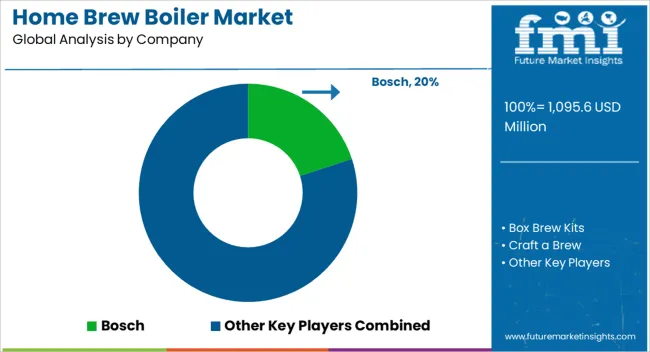
Bosch is one of the leading players in the home brew boiler market with its range of energy-efficient products. The company has been aggressive in its marketing campaign, targeting homeowners and small businesses with its message of 'Save money with Bosch'.
Similarly, home brew boiler manufacturers such as Box Brew Kits, Craft a Brew, Northern Brewers, and Shandong Zunhuang Brewing Equipment Co. Ltd. are leading at the forefront in this market space. These companies are utilizing a wide range of strategies such as new product launches, partnerships, collaborations, and acquisitions to solidify their position in the global market. For instance,
| Attribute | Details |
|---|---|
| Estimated Market Size (2025) | USD 1095.6 million |
| Projected Market Size (2035) | USD 1853.8 million |
| Anticipated Growth Rate (2025 to 2035) | 5.4% |
| Forecast Period | 2025 to 2035 |
| Historical Data Available for | 2020 to 2025 |
| Market Analysis | USD Million for Value and Units for Volume |
| Key Regions Covered | North America; Latin America; Europe; Asia Pacific; Oceania; Middle East & Africa (MEA) |
| Key Countries Covered | The US, Canada, Mexico, Germany, The UK, France, Italy, Spain, China, Japan, India, South Korea, Australia, Brazil, Argentina, South Africa, UAE |
| Key Segments Covered | Technology, Application, Capacity, Region |
| Key Companies Profiled | Bosch; Box Brew Kits; Craft a Brew; Kilner; Home Brewing Co; MrBeer; WilliamsWarn; Victor’s; Northern Brewers; Shandong Zunhuang Brewing ; Equipment Co., Ltd.; Woodforde's; LG Electronics; PicoBrew, Inc |
| Report Coverage | Company Share Analysis, DROT Analysis, Market Dynamics and Challenges, Strategic Growth Initiatives, Market Forecast, Competitive Landscape, |
The global home brew boiler market is estimated to be valued at USD 1,095.6 million in 2025.
The market size for the home brew boiler market is projected to reach USD 1,853.8 million by 2035.
The home brew boiler market is expected to grow at a 5.4% CAGR between 2025 and 2035.
The key product types in home brew boiler market are electric system and gas fired system.
In terms of application, beer segment to command 64.0% share in the home brew boiler market in 2025.






Our Research Products

The "Full Research Suite" delivers actionable market intel, deep dives on markets or technologies, so clients act faster, cut risk, and unlock growth.

The Leaderboard benchmarks and ranks top vendors, classifying them as Established Leaders, Leading Challengers, or Disruptors & Challengers.

Locates where complements amplify value and substitutes erode it, forecasting net impact by horizon

We deliver granular, decision-grade intel: market sizing, 5-year forecasts, pricing, adoption, usage, revenue, and operational KPIs—plus competitor tracking, regulation, and value chains—across 60 countries broadly.

Spot the shifts before they hit your P&L. We track inflection points, adoption curves, pricing moves, and ecosystem plays to show where demand is heading, why it is changing, and what to do next across high-growth markets and disruptive tech

Real-time reads of user behavior. We track shifting priorities, perceptions of today’s and next-gen services, and provider experience, then pace how fast tech moves from trial to adoption, blending buyer, consumer, and channel inputs with social signals (#WhySwitch, #UX).

Partner with our analyst team to build a custom report designed around your business priorities. From analysing market trends to assessing competitors or crafting bespoke datasets, we tailor insights to your needs.
Supplier Intelligence
Discovery & Profiling
Capacity & Footprint
Performance & Risk
Compliance & Governance
Commercial Readiness
Who Supplies Whom
Scorecards & Shortlists
Playbooks & Docs
Category Intelligence
Definition & Scope
Demand & Use Cases
Cost Drivers
Market Structure
Supply Chain Map
Trade & Policy
Operating Norms
Deliverables
Buyer Intelligence
Account Basics
Spend & Scope
Procurement Model
Vendor Requirements
Terms & Policies
Entry Strategy
Pain Points & Triggers
Outputs
Pricing Analysis
Benchmarks
Trends
Should-Cost
Indexation
Landed Cost
Commercial Terms
Deliverables
Brand Analysis
Positioning & Value Prop
Share & Presence
Customer Evidence
Go-to-Market
Digital & Reputation
Compliance & Trust
KPIs & Gaps
Outputs
Full Research Suite comprises of:
Market outlook & trends analysis
Interviews & case studies
Strategic recommendations
Vendor profiles & capabilities analysis
5-year forecasts
8 regions and 60+ country-level data splits
Market segment data splits
12 months of continuous data updates
DELIVERED AS:
PDF EXCEL ONLINE
Home Sleep Screening Device Market Size and Share Forecast Outlook 2025 to 2035
Home Healthcare Software Industry Analysis in North America Size and Share Forecast Outlook 2025 to 2035
Home Decor Market Size and Share Forecast Outlook 2025 to 2035
Home Automation Sensors Market Size and Share Forecast Outlook 2025 to 2035
Home Energy Management Systems Market Size and Share Forecast Outlook 2025 to 2035
Home Dialysis Systems Market Size and Share Forecast Outlook 2025 to 2035
Home Standby Gensets Market Size and Share Forecast Outlook 2025 to 2035
Home Scales Market Size and Share Forecast Outlook 2025 to 2035
Home Gym Equipment Market Size and Share Forecast Outlook 2025 to 2035
Homeland Security Market Size and Share Forecast Outlook 2025 to 2035
Home Wi-Fi Security Solutions Market Size and Share Forecast Outlook 2025 to 2035
Home Security Drone Market Size and Share Forecast Outlook 2025 to 2035
Home Infusion Therapy Devices Market Analysis - Size, Share, and Forecast Outlook 2025 to 2035
Home Healthcare Market Analysis - Size, Share, and Forecast Outlook 2025 to 2035
Homeopathic Products Market Analysis - Size, Share, & Forecast Outlook 2025 to 2035
Home Care Services Market Size, Growth, and Forecast 2025 to 2035
Home Sleep Apnea Testing Market Analysis - Size, Share, and Forecast Outlook 2025 to 2035
Home Office Spending Market by Solution Deployment, Application & Region Forecast till 2025 to 2035
Home Baking Ingredients Market Growth - Consumer Trends 2025 to 2035
Home Respiratory Therapy Market – Growth & Forecast 2025 to 2035

Thank you!
You will receive an email from our Business Development Manager. Please be sure to check your SPAM/JUNK folder too.
Chat With
MaRIA